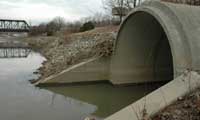 |
| Great Lakessystem contains one-fifth the earths surface water. (Map by Army Corps of Engineers) |
The Great Lakes ecosystems are dying a slow and painful death. Lax enforcement of the Clean Water Act is causing the lakes to regress to pollution levels not seen since the 1960s, say environmentalists. A �dead zone� has reemerged in Lake Erie. The lakes had 2,980 days of beach closings and advisories in 2004, climbing 737% since 2000. The states bordering the lakes are scrambling to save the ecosystems that create an annual economic boon of $15 billion in tourist dollars alone.
�The Lakes are starting to see an ecological breakdown at the largest levels,� says Andy Buchsbaum, director of the Great Lakes� office of the National Wildlife Federation. Ecosystems are failing in areas where the contamination levels are far lower than the historical failure threshold. �The Lakes seem to be losing their resiliency,� he says.
 click here for slide show click here for slide show
|
The looming ecological crisis prompted the governors of New York, Pennsylvania, Ohio, Wisconsin, Michigan, Illinois, Indiana, and Minnesota to ask the federal government for help in 2004. President Bush responded with an executive order creating the Great Lakes Regional Collaboration.
 |
| Along much of the Great Lakes 10,900 miles of shoreline, people and industry often share the same space. (Photo by National Park Service.) |
Officials established eight independent teams to address a group of complex, interconnected issues: invasive species, species and habitat decline, costal health, Areas of Concern restoration and sediments cleanup, non-point source and persistent bioaccumulative toxins reduction, sustainable development, and information and indicators systems.
The teams are composed of federal, state, local, private, and industry representatives and headed by co-chairs. They compiled five point recommendations that could be limited to five or six pages. A preliminary report was published for public comment on July 7. The current draft says that the region�s ecosystems need almost $20 billion in work over the next five years. The comment period closes September 9 after upcoming meetings in Detroit, Cleveland, and Buffalo. The teams will reconvene to adjust the plan before publishing a final version on December 12.
Coastal zone improvements will capture the lion�s share of capitol investment. The team called for $13.7 billion in federal and constituent dollars over the next five years to repair the region�s waste treatment infrastructure. The investment would reduce sewage and industrial waste dumping by 95%. The combined sewer systems that pervade the region would absorb the majority of the money. Michigan is a not so shining example of the need for upgrades in the region. Regulators recorded 27.1 billion gallons of combined sewer overflows (CSO) and 178 million gallons of sanitary sewer overflows (SSO) in 2004. Most of the untreated effluent likely reached the lakes.
 |
| Correcting sewer overflows will cost at least $13.7 billion, says an advisory group. (Photo by Public Interest Research) |
Funding would jump-start new repairs and speed existing efforts. Chicago has been working to eliminate CSOs since the 1960s but federal dollars have long since dried up, says Jack Farnan, general superintendent of the Metropolitan Water Reclamation District of Chicago. The city hopes to finish an 18- billion-gallon sewer overflow containment system by 2015, he says. The completed system will consist of 109 miles of 12-foot to 35-foot tunnel placed 300 feet underground. The collection system will flow to three reservoirs. The city is also investing $800 million to replace wastewater treatment plants in Stickney and Calumet, which are over 70 years old, says Farnan.
Some of the money for resolving the sewage issues would be spent in a more budget friendly manner. The team has proposed incentives to encourage home-owners and business to divert storm water to places other than their combined sewers, says Mike Shriberg, Michigan state director of the Public Interest Research Group and member of the costal health team. Creating storm water holding programs could reduce the cost of sewer upgrades from 10% to 50% in some localities, he says.
The funding for these proposals would be split 45/55 between local and federal dollars, says Shriberg. �There are lots of plans to restore the Great Lakes collecting dust on shelves somewhere. This one will suffer the same fate if the federal government doesn�t provide funding.�
 |
| Airborne and waterborne pollutants from papermills are a consistent threat to the environment. (Photo byJohn Robbins, Great Lakes Environmental Research Lab, NOAA) |
An additional $3 billion will be needed to drive a persistent project, remediation of Areas of Concern, to conclusion. The U.S.-Canadian International Joint Commission of 1987 identified 31 AOCs on the American side of the lakes. The Great Lakes Legacy Act passed in 2002 and was to fix these areas but progress has been slow, says David Cowgill, co-chair of the AOC/Sediments team. His team calls for $150 million in dedicated federal funding through 2020, mostly to remediate 75 million cubic yards of contaminated soil spread throughout the AOCs. The strategy also would amend of the already in-place Great Lakes Legacy Act to streamline the cleanup process. The effort needs better coordination, say Cowgill. There is no committee to organize the efforts of federal, state, and local, creating inefficiency, he says.
Resolving non-point pollution issues will be less expensive but still will require $1.2 billion over the next five years. The money would go towards restoring wetlands, reducing agricultural runoff, and creating buffers to eliminate excessive sediment flows into the lakes. The cost of habitat restoration heavily overlaps with non-point pollution, as the habitats most in need of restoration are the wetlands. An additional $500 million would go towards restoring other habitats.
 |
| Untreated sewage discharge is a persistent problem that seems to be getting worse in an era of regulatory benign neglect. (Photo by Great Lakes Environmental Research Lab) |
One major area that can be improved with little funding is sustainable development, says Jan Miller, co-chair of the sustainable development team. Major contamination cleanups often can be executed at no cost to the taxpayer through brownfields, but bad state and local regulations often discourage such projects, he says. Most land use decisions are made at a local level with no consideration for the regional impact, he says. �Many places have regulations that actually encourage less sustainable and poor land use.� Regional integration of resource management should solve most of these issues, says Miller.
Despite Herculean efforts of the collaboration, there is still a large, angry elephant in the room. Its name is mercury. The heavy metal, linked by medical studies to neurological and reproductive problems, has become a contaminant of concern to public health officials and public interest groups. James Zorn, co-chair of the toxins reduction team, acknowledges that his team failed to effectively address mercury. �We felt that we couldn�t fight the federal rule, so we decided focus on problems we could solve.� He adds that the lax regulation of mercury levels angers him and his constituents. �The rate and reduction schedules are questionable. We want a reduction of mercury levels and are concerned about new coal fired plants coming online.�
 |
| In 2004, therewere 2,980 instances of beach closings and advisories throughout the Great Lakes system, a seven-fold increase since 2000. (Photo by David Riecks, Illinois-Indiana Sea Grant) |
The inroads that can be made will have to come at a local level, says Zorn. Significant amounts of mercury and other contaminants originate from solid waste disposed of by individuals and businesses, he says. Educating the public about the importance of better disposal practices will both reduce pollution and raise awareness of the problem. Awareness is crucial to creating the political will needed to force the hand of the administration, he says.
Zorn worries about more than mercury. He fears that the plan could harm environmental efforts at a local level. �Over-consolidating the problems of such a massively geographically and ecologically diverse region could actually cause a loss of overall funding to the region,� he says. Zorn still acknowledges that the Great Lakes states must band together to get the desperately needed federal dollars. Dwindling representation in Congress means that their delegations must present a unified front if they are to wield enough political power to push a funding initiative through both houses of the Congress, he says.

Post a comment to this article
Report Abusive Comment